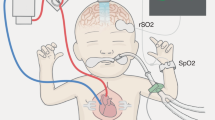Abstract
This study was performed to evaluate the feasibility of intraoperative point-of-care trans-fontanellar cerebral ultrasonography (TFCU) to obtain blood flow velocity (BFV) reference values at the internal carotid arteries (ICAs) and peri-callosal part of the anterior cerebral artery (pACA) during pediatric cardiac surgery under cardiopulmonary bypass (CPB). TFCU was performed at three time points (after induction of anesthesia, during CPB, after CPB) in 35 infants. BFV was measured at both ICAs and pACA through the anterior fontanelle with an ultrasound sector probe. We divided patients into Group S (<5 kg, n = 16) and Group L (≥5 kg, n = 19) for comparisons according to weight. We also analyzed BFV in low cerebral regional oxygen saturation (rSO2) data. All measurements of the BFV at both the ICAs and the pACA were possible. BFVs at the ICAs were lower in Group S than in Group L at all three time points. BFVs at the pACA were similar in both groups except higher value in Group L after CPB. When the rSO2 was <50, most BFVs (14 of 15 measurements) were lower than the median BFV value during CPB. However, a low rSO2 did not always reflect low BFV before and after CPB. Point-of-care TFCU can determine BFV at the ICAs and pACA during pediatric cardiac surgery. BFV differs according to the patient’s size and CPB application. TFCU can be a practical cerebral blood flow monitoring method when rSO2 changes without any specific reason in infants.
ClinicalTrials.gov NCT01996020.


Similar content being viewed by others
References
Polito A, Ricci Z, Di Chiara L, Giorni C, Iacoella C, Sanders SP, Picardo S. Cerebral blood flow during cardiopulmonary bypass in pediatric cardiac surgery: the role of transcranial Doppler–a systematic review of the literature. Cardiovasc Ultrasound. 2006;4:47.
Gottlieb EA, Fraser CD Jr, Andropoulos DB, Diaz LK. Bilateral monitoring of cerebral oxygen saturation results in recognition of aortic cannula malposition during pediatric congenital heart surgery. Paediatr Anaesth. 2006;16:787–9. doi:10.1111/j.1460-9592.2006.01989.x.
de Assis MC, Machado HR. Transfontanellar Doppler ultrasound measurement of cerebral blood velocity before and after surgical treatment of hydrocephalus. Arq de Neuropsiquiatr. 1999;57:827–35.
Nzeh DA, Ajayi OA. Sonographic diagnosis of intracranial hemorrhage and periventricular leukomalacia in premature African neonates. Eur J Radiol. 1997;26:77–82.
Hagmann CF, Robertson NJ, Acolet D, Chan D, Onda S, Nyombi N, Nakakeeto M, Cowan FM. Cranial ultrasound findings in well newborn Ugandan infants. Arch Dis Child Fetal Neonatal Edition. 2010;95:F338–44. doi:10.1136/adc.2009.174607.
Cooper WA, Duarte IG, Thourani VH, Nakamura M, Wang NP, Brown WM III, Gott JP, Vinten-Johansen J, Guyton RA. Hypothermic circulatory arrest causes multisystem vascular endothelial dysfunction and apoptosis. Ann Thorac Surg. 2000;69:696–702.
Andropoulos DB, Stayer SA, McKenzie ED, Fraser CD Jr. Novel cerebral physiologic monitoring to guide low-flow cerebral perfusion during neonatal aortic arch reconstruction. J Thorac Cardiovasc Surg. 2003;125:491–9. doi:10.1067/mtc.2003.159.
Lee JH, Min SH, Song IK, Kim HS, Kim CS, Kim JT. Control of cardiopulmonary bypass flow rate using transfontanellar ultrasonography and cerebral oximetry during selective antegrade cerebral perfusion. J Cardiothorac Vasc Anesth. 2015. doi:10.1053/j.jvca.2015.03.006.
Allison JW, Faddis LA, Kinder DL, Roberson PK, Glasier CM, Seibert JJ. Intracranial resistive index (RI) values in normal term infants during the first day of life. Pediatr Radiol. 2000;30:618–20.
Gray PH, Tudehope DI, Masel JP, Burns YR, Mohay HA, O’Callaghan MJ, Williams GM. Perinatal hypoxic-ischaemic brain injury: prediction of outcome. Dev Med Child Neurol. 1993;35:965–73.
Bracci R, Perrone S, Buonocore G. The timing of neonatal brain damage. Biol Neonate. 2006;90:145–55. doi:10.1159/000092517.
Author information
Authors and Affiliations
Corresponding author
Ethics declarations
Conflict of interest
None.
Rights and permissions
About this article
Cite this article
Park, YH., Song, IK., Lee, JH. et al. Intraoperative trans-fontanellar cerebral ultrasonography in infants during cardiac surgery under cardiopulmonary bypass: an observational study. J Clin Monit Comput 31, 159–165 (2017). https://doi.org/10.1007/s10877-015-9815-3
Received:
Accepted:
Published:
Issue Date:
DOI: https://doi.org/10.1007/s10877-015-9815-3




